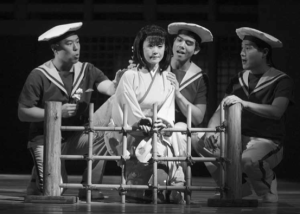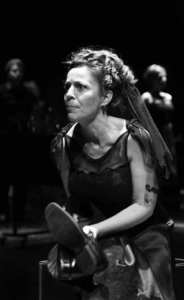Incorporating Stephen Sondheim’s catalog into the university performing arts training studio can be both exciting and discouraging. This is because even the most basic material would require a fairly sophisticated understanding of vocal music, interpretive skill and acting chops. Those who are rhythmically challenged, requiring melodies doubled in accompaniments or unable to make clear acting choices will find themselves unsuited to performing a Sondheim song successfully. Examining, learning, working on and performing songs in the academic environment refocuses the work from the expectations of a paying audience and bears its concentration heavily on the individual performer, the scene partner and an instructor in artificial terrain.

There are ample rewards, however, for those studying musical theatre techniques in a workshop or master class if the initial pedagogy has been structured well. First, theatre or music students need not bow to the given circumstances of the song as long as they have a clear understanding of the character’s situation and intention, and the song structure and language. There is absolutely no singular way to achieve this, as countless professional productions on Broadway and in London have demonstrated through imaginative re-contextualizing and inventive storytelling. One only has to search YouTube for a video clips of “I’m Still Here” or “The Worst Pies in London” or “Being Alive” to realize the divergent, multifarious renditions that start with Sondheim’s composition but honor the craft of the singing actor’s interpretive skill.
There is abundance of material to choose from, especially in the post-1970 Sondheim scores, and many lessons to be learned from selecting specific musical theatre moments to assign to students that form a compelling study tools. Material selected should be chosen to reinforce the singer’s strengths. It isn’t usually recommended to choose material that is counter to the performer’s tessitura, and vocal key changes should accommodate the singer’s range. Selections should also try to address age appropriateness of material. Obviously it is important to stretch the student, but it’s not particularly useful for a 21-year-old to perform Madame Armfeldt’s “Liaisons.” This doesn’t mean there is not some value in inhabiting older characters but, in general, it is preferable to assign material that will maximize performers’ assets and minimize weaknesses. There are countless examples, of course, but here are some suggestions:
I Want/I Am Songs: These are usually offered toward the beginning of well-structured musicals because they propose an early explanation of characters’ wants and desires. Every Sondheim show contains such numbers for most of the principals. Many of these have standard or slightly modified AABA structures. This is instructive because it makes for thoughtful exercises in analysis of how the stakes get heightened with the second A section and how the release in the B section operates both independently and simultaneously with the return to the main melody.
“Green Finch and Linnet Bird” from Sweeney Todd, “Lovely” from Forum, “Soon” from A Little Night Music, “I Remember” from Evening Primrose, “I Know Things Now” and “On the Steps of the Palace” from Into the Woods all work well for sopranos and mezzo-sopranos in the college setting. In addition, “The Miller’s Son” from Night Music, though placed in the show’s penultimate spot before a series of resolving reprises, is a virtuosic opportunity for the treble voice because it contains full-throated phrasing, inconstant meters, alliteration and both internal and triple rhymes. The song, which incorporates elements of a list song and a charm song as well, almost requires a seat belt for the listener. “Giants in the Sky” from Into the Woods, “Later” from Night Music, “Love, I Hear” from Forum, “Someone Is Waiting” from Company, “Johanna” from Sweeney Todd and “Finishing the Hat” from Sunday offer bountiful moments for tenors and baritones.
Musical Scene: The overarching purpose of this type of song is to integrate recitative, aria and arioso with one cohesive objective. Oscar Hammerstein II promulgated the form, and we see clear, practiced and highly effective demonstrations of his influence in the scores of Sweeney Todd, Into the Woods and Passion. In the duetscene “We Do Not Belong Together” from Sunday , the young model, Dot, visibly pregnant with George’s child, has decided to leave Paris. It’s a dramatic confrontation that attaches Lapine’s dialogue to the ostinato from the “Color and Light” leitmotif and then to a lyrical recitative that resolves into an aria that uses the hook “we do not belong together” as the central idea. It ends with the foreshadowed phrase sung by Dot, “I have to move on.”
The scene offers the challenges of singing fluid dialogue over shifting harmonics. The students must also gain stamina and skill of counting – especially because the rhythmic patterns are constantly shifting – counterpoint, fluctuating meters and a lush, melodic section (“You are complete, George”) that requires a conversational freedom but must respect the 3/2 meter. Dot’s range must accommodate a G below middle G up to a fully expressive D. This musical scene is thrilling compositional writing with a lyric that seamlessly transitions from book to singing. It’s a flawless example of separating what is spoken from what needs to be sung. It will be really hard on the musical students – but the payoff is worth it.
Duets: These musical conversations are essential for scene partnering; they are one of the fundamental components of studying the craft of acting. They are sung, rather than spoken, because their exchanges are heightened and demand music to push them forward. The song “I Am Unworthy of Your Love” from Assassins is perfectly suited for the male and female voice and arises effortlessly out of a book scene. With its pop-style accompaniment the duet has a combination hook that unifies two characters who are unaware that they are singing at the same time. It shifts a whole step, moving from Hinckley to Fromme, and moves efficiently to an echoing bridge and then returns to harmonize the two voices, all instructive components for study. The songs “Agony” from Into the Woods and “Getting Married Today” from Company are classic list songs, one of Sondheim’s ingenious specialties. The engaging barcarolle exchange between the two Princes yields hysterical benefits and is always a crowd-pleaser as long as the singers accept early on that the humor must arise out of their truthfulness rather than attempts to be funny. The strong/weak beat of the 6/8 meter cannot eclipse the conversational flow of the song. In “Getting Married Today,” the marriage of speed and comprehension is the singer’s objective. There’s no point in listening to Amy unless we can understand what is propelling the pre-marital panic attack. Because the lyrical barrage the first time the patter begins is so overwhelming, the singer must master the pacing. The sweet tenor of Paul’s counterpoint must not be disregarded; opposites attract but musically their voices must blend.

Trio: One of the most delicate examples of vocal writing for a small ensemble is “Pretty Lady” from Pacific Overtures. The song arises out of a short scene with three 19th-century British sailors who have come upon a lone Japanese woman in her garden and assume she is for sale. The sincerity in their belief, as well as the poignant texture of the song, is a gorgeous moment in which the audience understands the sailors’ confusion but knows that the woman is not what the boys think she is. The lilting 3/4 time sets up vocal lines that weave in and out; they both overlap and cross each other. This is significant because the exchanges mean that one singer is not always on top, in the middle or on the bottom. The sailors must distinguish themselves as separate characters with their own demeanor without sacrificing the unity of the piece. There are distinct locations in the song that demand perfectly placed fourths and triads. Oh, they’re all Cockney, too, so here’s a chance to sing in dialect.
Of course there are many other solos, duets, trios, quartets and ensemble songs waiting to be performed by eager students. The Sondheim inventory is rich with opportunities for the singing actor to train, develop and expand skills for a career in the unique art of singing for musical theatre.